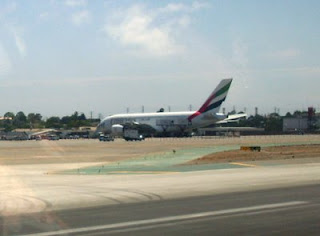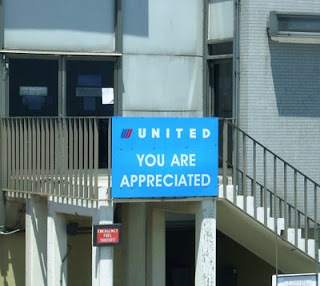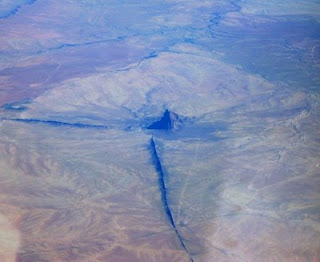
I guy I sat next to on the commute home yesterday asked me about the worst landing I ever had. I dodged the question, telling him I was a product of Vance Air Force Base where bad landings are not tolerated. But, in case you're wondering the same thing, here is a memoir from a couple of years ago:
My First Officer, a kid named Lane—can’t remember his first name—was a tanned, robust-looking lad who wore designer sunglasses and smiled with a chin-jutting aviator’s grin that made him look experienced beyond his years. Lane didn’t have military experience. He had “come up through the ranks,” had earned his way here through commercial aviation’s back alleys. As with most young pilots with that background, I found him highly competent and dependable but still not quite fully savvy to the crazy, unexpected stuff that happens; things not in the books.
Yet he was smooth on the controls. I liked that about Lane. I liked it too much. I got complacent. I was slumped back in my seat yawning that day.
Oh, that day.
We rolled out on final approach for runway 16 Left at Denver. It was a pleasant early summer morning, not too hot. The wind shear that commonly stalks Denver in the summer was off duty. Being the “non-flying pilot” or NFP in United parlance, I slumped in my seat and pondered my lunch selection. We had an hour and a half wait before leaving for San Francisco.
Lane had the ILS needles “wired” and his airspeed was perfect. He handled the controls like he was giving them a well deserved, caressing massage. I had seen Lane perform and was perfectly confident in him.
After the gear was down and the flaps set I read the Final Descent Checklist, then slumped back. I glanced out to the left window and watched farms rushing by, yawned and wondered if I might try a taco salad when we got to the terminal. I saw the radio altimeter click down through 1,000 feet and made my mandatory call-out. “One thousand feet. Instruments cross checked.”
Lane responded as required, “Runway One Six Left in sight. Cleared to land.”
I yawned again and thought the mesquite grilled chicken sandwich might be better. Then I heard a recorded voice come through our speakers. “Fifty feet.” The jet was reminding us, as it always did, that the earth was very, very near. Lane was doing well, over the threshold at 40 feet, just as he should be.
I first noticed the trouble just as the voice said, “Thirty feet.” An empty feeling rushed into my gut, like the bottom of the plane was falling out. My eyes verified it.
The runway started to leap up at us. It felt as if there was no more air under our wings, like we had suddenly flown into a vacuum. I looked at the throttles.
Lane should be shoving them forward to give us a burst of thrust and speed, but he wasn’t. I knew we were going to cause serious damage if we let the nose wheel strike the ground at that angle and descent rate.
So did Lane. He hauled back on the yoke, but with no energy available to complete the flare the Boeing only swapped ends and sank even faster. I stiffened. I was about to be served a generous ration of hell for lunch.
As if being dropped from a crane 20 feet above the ground, the 115,000 pound jet slammed onto the concrete with an impact that shook the airframe like it had been hit with a colossal sledge hammer, accompanied by a vicious booming sound, like the gear struts were being driven through the wings. Before my hands could find the yoke we were airborne again, nose high, stalling. The right wing dipped and Lane cut the yoke left while trying to reduce the pitch.
The jet sluggishly rolled left, nose high, descending again. I yelled, “THE ENGINE! WATCH THE ENGINE!”
Lane knew what I meant. The 737’s engines hang so low that a bank angle over nine degrees will cause them to strike the ground. He jerked the yoke right and the wings slugged that direction just before we struck the runway again.
The second impact was as violent as the first. I sat strapped inside a chamber of horrors watching the horizon rock left and right, wheels slamming against concrete shaking the panels, blurring our view of the runway ahead, the noise drowning out our curses.
Again we bounced but only slightly, and finally it was over. Lane steered us onto the high-speed exit ramp and motioned for me to take over. I looked at him. His tan had faded into a ghostly sheen. He breathed heavily through clenched teeth. I took the controls and saw an uncommon sight, my right hand shaking on the throttles.
“Dude,” I said. “What happened?”
“I don’t know,” he said. “I just don’t know.”
I told him to call the cabin to see if the “rubber jungle” was out. Sometimes a hard landing will cause the passenger oxygen masks to deploy from the ceiling.
Somebody who once saw that happen likened the dangling masks to jungle vines and so dubbed the bizarre sight. Lane picked up the interphone handset and called back. He asked if the masks were down.
They weren’t. He asked the forward flight attendant if every one was okay. I heard him say, “I’m sorry, man. I’m sorry.”
At the gate we shut the engines down and sat, staring out the windshield, hearing people shuffle off. “You want to open the door?” Lane finally asked. I did not. I didn’t want to face those people. What would I do? Point at Lane and say, “He did it”?
“No. We’ve got to talk.”
Lane reviewed the terrible twenty seconds but seemed not to remember much. We talked about what we could or should have done. I asked him if he got the empty gut feeling just before the sink started, as I did.
He said he thought so, but I wondered. I told him, “Next time, Power! Power! Power!” He nodded, his head hanging low, embarrassed and scared.
“Shake it off,” I said. “I’ve seen you fly. You’re a good pilot. It won’t happen again.”
He nodded.
I told him to go out and inspect the engine nacelles to make sure they weren’t damaged, and I called maintenance for an airframe inspection. Thanks to the sturdy designs of the Boeing Aircraft and Storm Door Manufacturing Company, they found no damage.
The next day we were back on final approach to 16L at Denver, Lane at the controls again. It was another good day. I knew Lane would be watching to see if I was close with my hands ready to take the controls. I wanted to do just that, but I decided not to. If I truly believed what I had told him the previous day about my having confidence in him, then I had to show it. I slumped back in my seat.
“Fifty feet,” the jet’s voice told us. “Thirty…ten.” Lane flared nicely. We hovered inches above the runway, the airspeed steadily decaying. We felt a gentle plop behind us, the main wheels touching. He flew the nose down. Another soft plop. He pulled the reversers into idle but didn’t use any reverse thrust. No need. We had plenty of runway and our turn-off was down toward the end. As the Boeing slowed we heard the high-pitched whine of the rotating nosewheels getting softer and softer, as they spun down. Lane took the high speed exit and motioned for me to take over.
I took over and said, “You kissed and made up with that runway, I see.”
He laughed. His tan and his co nfidence back, Lane became his perky self again, in the days ahead recounting and laughing at his punishing landing. “Take that, Runway! Pow! And that! And That! That’ll teach you a lesson you won’t forget!”
nfidence back, Lane became his perky self again, in the days ahead recounting and laughing at his punishing landing. “Take that, Runway! Pow! And that! And That! That’ll teach you a lesson you won’t forget!”
And that, was the worst landing I ever sat through.
































